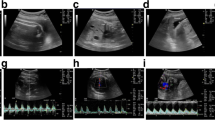Abstract
Purpose of Study
This study aimed to compare the prenatal ultrasound parameters- fetal lung biometry and pulmonary artery Doppler in preterm newborns for prediction of respiratory distress (RD).
Methods
A prospective analytic study was conducted in Department of Obstetrics and Gynecology in collaboration with Department of Neonatalogy. Fetal ultrasound and Doppler parameters were evaluated in women predisposed to have preterm delivery at or before 34 weeks. The neonates were followed for occurrence of RD.
Result
Out of 100 study population, neonates who developed RD were taken as cases (n = 36) and rest were grouped as controls (n = 64). The gestational age at delivery, mean birth weight and Apgar score were significantly less in cases than controls. All the fetal lung biometric parameters were significantly less in cases than controls (p value < 0.001). The fetal lung volume had highest sensitivity (72.22%) and negative predictive value (83%). The right lung area had highest specificity (89%) and positive predictive value (72%). Among the Doppler parameters, the At/Et ratio showed high degree of accuracy (68%). The sensitivity and specificity were 55.56% and 75%, respectively. The positive and negative predictive values were 72% and 60%, respectively.
Conclusions
Both fetal lung biometry and pulmonary artery Doppler offer an excellent noninvasive approach for assessment of fetal lung maturity, clinically assessed by RD. On comparison of all the ultrasound parameters, fetal lung volume and At/Et ratio showed highest degree of accuracy in prediction of RD.



Similar content being viewed by others
References
Liu L, Oza S, Hogan D, et al. Global, regional, and national causes of under- 5 mortality in 2000–15: an updated systematic analysis with implications for the sustainable development goals. Lancet. 2016;388(10063):3027–350.
Swarnkar K, Swarnkar M. Neonatal respiratory distress in early neonatal period and its outcome. Int J Biomed Adv Res. 2015;6(9):643–7.
Dyer J. Neonatal respiratory distress syndrome: tackling a worldwide problem. P T. 2019;44(1):12–4.
Chandrasekharan PK, Rawat M, Madappa R, et al. Congenital Diaphragmatic hernia—a review. Matern Health Neonatol Perinatol. 2017;3:6.
Triebwasser JE, Treadwell MC. Prenatal prediction of pulmonary hypoplasia. Semin Fetal Neonatal Med. 2017;22(4):245–249. https://doi.org/10.1016/j.siny.2017.03.001.
Kontopoulos EV, Quintero LF, Chmait R. The quantitative lung index: the left lung. J Matern-Fetal & Neonatal Med. 2020. https://doi.org/10.1080/14767058.2020.1847076.
Moeglin D, Talmant C, Duyme M. Fetal lung volumetry using two- and three-dimensional ultrasound. Ultrasound Obstet Gynecol. 2005;25:119–27.
Duncan JR, Tobiasz AM, Dorsett KM, et al. Fetal pulmonary artery acceleration/ejection time prognostic accuracy for respiratory complications in preterm prelabor rupture of membranes. J Matern-Fetal Neonatal Med. 2020;33(12):2054–8.
Sweet LR, Keech C, Klein NP, Marshall HS, Tagbo BN, Quine D, Kaur P, Tikhonov I, Nisar MI, Kochhar S, Muñoz FM; Brighton Collaboration Respiratory Distress in the Neonate Working Group. Respiratory distress in the neonate: Case definition & guidelines for data collection, analysis, and presentation of maternal immunization safety data. Vaccine. 2017;35(48 Pt A):6506–6517. https://doi.org/10.1016/j.vaccine.2017.01.046.
Büke B, Destegül E, Akkaya H, Şimşek D, Kazandi M. Prediction of neonatal respiratory distress syndrome via pulmonary artery Doppler examination. J Matern Fetal Neonatal Med. 2019;32(10):1640–1645. https://doi.org/10.1080/14767058.2017.1413549.
Laban M, Mansour G, El-Kotb A, et al. Combined measurement of fetal lung volume and pulmonary artery index is more accurate for prediction of neonatal respiratory distress in preterm fetuses: a Pilot study. J Matern-Fetal Neonatal Med. 2017;32:626–32.
Author information
Authors and Affiliations
Corresponding author
Ethics declarations
Conflict of interest
The authors have no conflict of interest.
Informed Consent
Informed consent has been taken from all participants included in the study.
Additional information
Publisher's Note
Springer Nature remains neutral with regard to jurisdictional claims in published maps and institutional affiliations.
Rights and permissions
About this article
Cite this article
Aafreen, S., Kumar, M. & Nangia, S. Prenatal Ultrasound Markers: A Comparative Study for Prediction of Respiratory Distress in Early Preterm Newborns. J Obstet Gynecol India 72 (Suppl 1), 198–203 (2022). https://doi.org/10.1007/s13224-021-01592-w
Received:
Accepted:
Published:
Issue Date:
DOI: https://doi.org/10.1007/s13224-021-01592-w




